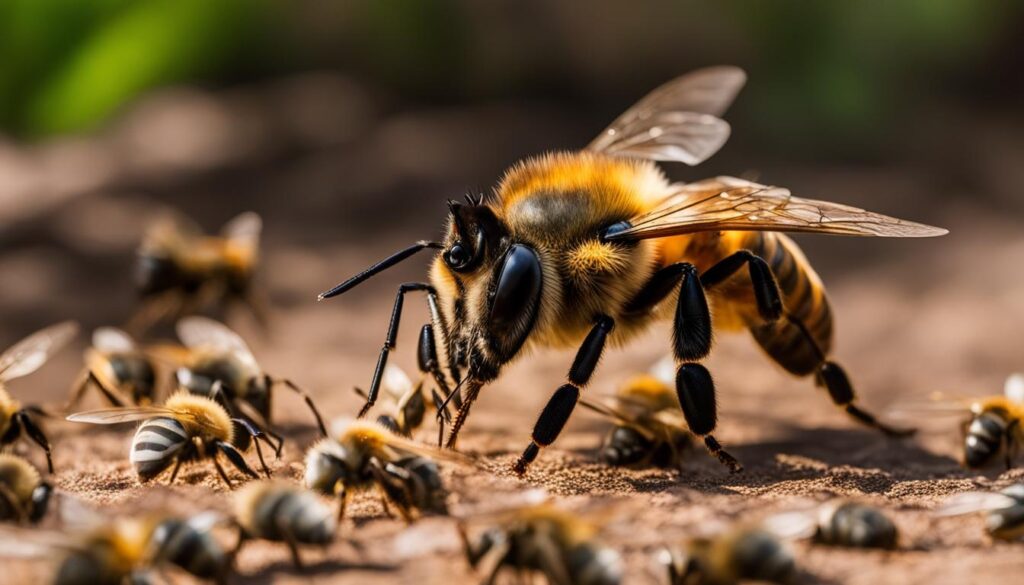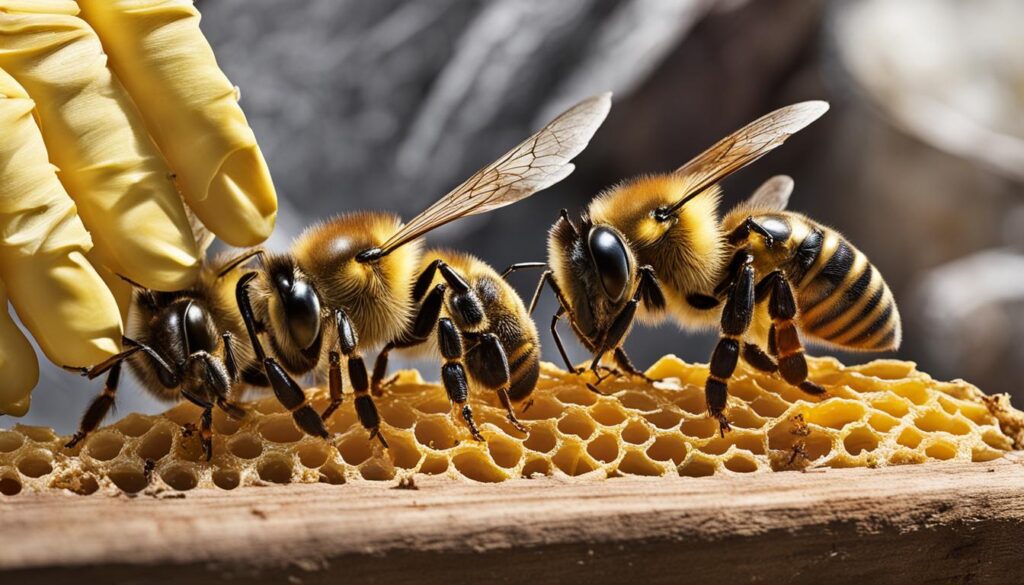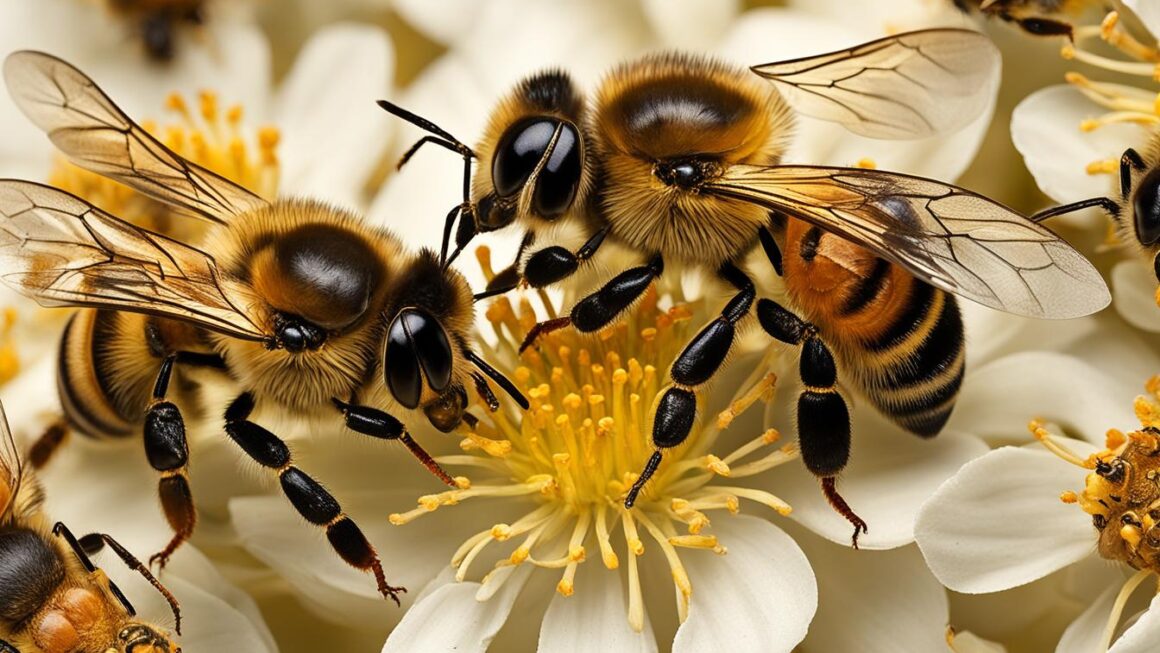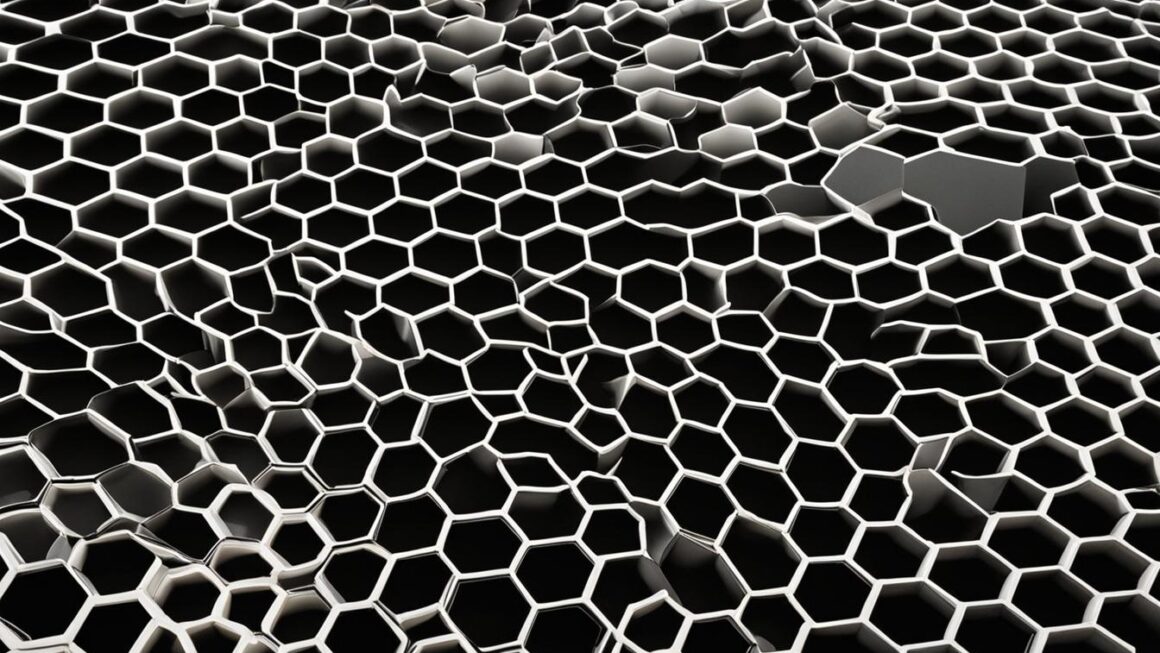Honey bee queens play a vital role in the colony, as they are responsible for laying fertilized eggs and maintaining the hive’s population. Their life cycle is an incredible journey, with different stages and tasks to fulfill. From egg laying to mating and maintaining the colony’s social structure, the queen’s life is full of challenges and responsibilities. This article will explore the detailed stages of the honey bee queen life cycle and provide fascinating insights into their development and role within the hive.
Key Takeaways:
- Understanding the honey bee queen life cycle is crucial for beekeepers and anyone interested in honey bee development.
- The queen bee plays a vital role in laying fertilized eggs and maintaining the hive’s population.
- The development of a queen bee starts from an egg, leading to the larva and pupa stages.
- The queen bee’s primary duty is to lay eggs, and she also releases pheromones to maintain the hive’s social structure.
- Mating flights and the storage of sperm are essential for genetic diversity and colony survival.
The Importance of the Queen Bee
The queen bee is a crucial member of the honey bee colony, playing a significant role in its survival and growth. She holds the responsibility of laying fertilized eggs, which ultimately leads to the production of worker bees. Without a healthy and productive queen, the entire colony’s existence is at risk.
One of the key functions of the queen bee is to maintain the social structure of the hive. She achieves this by releasing special pheromones that help coordinate the activities of the other bees. These pheromones play a vital role in communication and decision-making within the colony, ensuring that tasks are carried out efficiently and effectively.
Another important aspect of the queen bee’s role is the genetic diversity of the colony. During her mating flights, the queen bee mates with drones from other colonies, ensuring a mix of genetic material. This genetic diversity is essential for the colony’s long-term survival and adaptability to changing environments.
The significance of the queen bee cannot be overstated. She is the mother, the heart, and soul of the hive. Her ability to lay eggs and maintain the social structure ensures the growth and prosperity of the colony. Understanding and appreciating the importance of the queen bee is crucial for beekeepers and anyone interested in the fascinating world of honey bees.
Development of the Queen Bee
The development of a queen bee is a fascinating process that showcases the incredible transformation from an egg to a fully developed adult bee. This journey begins when the queen bee lays an egg, which is then cared for by the worker bees in the colony. After hatching from the egg, the larva is fed with royal jelly, a special food produced by the worker bees. This royal jelly triggers the development of the larva into a queen bee, setting her apart from the worker bees in both physical characteristics and reproductive abilities.
During the pupa stage, the queen bee undergoes metamorphosis, where she develops wings, legs, and other adult features that are crucial for her future duties. This stage is a critical period of transformation, as the queen bee transitions from a larva to a fully formed adult. Finally, the queen bee emerges from her cell as a fully developed adult, ready to take on her responsibilities within the hive.
The development of the queen bee is a testament to the intricate and complex nature of honey bee life cycles. It showcases the remarkable ability of these creatures to undergo metamorphosis and adapt to the needs of their colony. Understanding the development of the queen bee allows us to appreciate the important role she plays in the survival and success of the hive.
Table: Comparison of Queen Bee Development with Worker Bee Development
| Development Stage | Queen Bee | Worker Bee |
|---|---|---|
| Egg | Laid by the queen bee | Laid by the queen bee |
| Larva | Fed with royal jelly, undergoes metamorphosis | Fed with a mixture of pollen and honey, undergoes metamorphosis |
| Pupa | Develops adult features, including wings and legs | Develops adult features, including wings and legs |
| Adult | Fully developed queen bee ready for reproduction | Fully developed worker bee ready for various colony tasks |
Duties of the Queen Bee
As the leader of the honey bee colony, the queen bee has several important duties and responsibilities. Her primary role is to lay eggs, ensuring the continuous growth and survival of the hive. The queen bee is the only member of the colony capable of laying fertilized eggs, which develop into worker bees that perform various tasks within the hive. Without the queen’s egg-laying abilities, the colony would not be able to sustain its population.
In addition to egg laying, the queen bee also plays a crucial role in maintaining the social structure of the hive. She releases pheromones that help coordinate the activities of the other bees, ensuring smooth communication and task allocation within the colony. These pheromones not only help in maintaining hive cohesion but also serve as a form of communication between the queen and the worker bees, providing important signals about the health and status of the hive.
Occasionally, the queen bee may also engage in what is known as a “queen flight.” During these flights, she mates with drones from other colonies, ensuring genetic diversity within the hive. This genetic diversity is essential for the colony’s survival and adaptability to changing environments. The queen bee’s duties and responsibilities are vital for the overall success and productivity of the honey bee colony.
Quotes
“The queen bee’s egg laying abilities are crucial for the colony’s survival and growth.”
Key Duties of the Queen Bee:
- Laying fertilized eggs
- Maintaining the social structure of the hive
- Releasing pheromones for communication and coordination
- Engaging in “queen flights” for genetic diversity
The Mating Process
The mating process of queen bees is a fascinating and essential aspect of their reproductive cycle. Queen bees engage in mating flights, where they leave the hive and venture out to meet drones from other colonies. These mating flights are critical for genetic diversity within the hive and contribute to the overall health and resilience of the colony.
During these flights, queen bees have the opportunity to mate with multiple drones, ensuring a wide variety of genetic material for their offspring. This genetic diversity is crucial for the colony’s ability to adapt to changing environmental conditions and to resist diseases and parasites.
After mating, the queen bee stores the sperm from the drones in her abdomen. This stored sperm is then used to fertilize eggs throughout her life, allowing her to continue laying fertilized eggs and maintaining a robust population within the hive.

The Importance of Mating Flights
Mating flights are a crucial part of a queen bee’s life cycle and have a significant impact on the overall health and success of the colony. By mating with drones from other colonies, the queen bee ensures genetic diversity within the hive, which is essential for the survival of the colony.
These mating flights also serve as a form of natural selection, as the queen bee has the opportunity to choose drones with desirable genetic traits. This selection process helps to maintain the overall strength and vitality of the colony, ensuring its ability to thrive and adapt in a changing environment.
Overall, the mating process of queen bees is a complex and crucial aspect of their reproductive cycle. It plays a vital role in the long-term survival and success of the colony, highlighting the incredible adaptability and resilience of these remarkable creatures.
Life Span of the Queen Bee
The life span of a queen bee can vary depending on various factors, such as environmental conditions and the overall health of the colony. On average, a queen bee can live for 3-4 years. However, some queens may have shorter lifespans due to factors like disease or reproductive decline. Beekeepers often replace older queens with younger ones to ensure the colony’s productivity and vitality.
The longevity of a queen bee is crucial for the overall success and sustainability of the colony. A healthy and productive queen bee can lay thousands of eggs each day, contributing to the population growth and survival of the hive. As the queen ages, her ability to lay fertilized eggs may decrease, which can lead to a decline in the colony’s productivity. Therefore, beekeepers closely monitor the lifespan of the queen and take necessary measures to maintain a vibrant and thriving colony.
| Factors Affecting Queen Bee Lifespan | Impact |
|---|---|
| Genetics | Determines the overall health and vigor of the queen bee. |
| Environment | External conditions such as temperature, humidity, and food availability can affect the queen bee’s lifespan. |
| Disease and Pests | Infestations or infections can weaken the queen bee and shorten her lifespan. |
| Reproductive Decline | As the queen ages, her ability to produce fertilized eggs may decline, leading to a decline in the colony’s population. |
Beekeepers play a vital role in ensuring the longevity and productivity of the queen bee. By providing a suitable environment, regular health checks, and proper nutrition, beekeepers can help extend the queen’s lifespan and maintain a vibrant colony. Additionally, the replacement of older queens with younger ones ensures the continuous production of worker bees and the overall health of the hive.
Replacement of the Queen Bee

The replacement of the queen bee is a critical process that occurs when the current queen’s reproductive abilities decline or she dies. The colony relies on a healthy and productive queen to ensure its survival and growth. Several reasons may necessitate the replacement of the queen bee:
- Reproductive decline: As the queen bee ages, her ability to lay fertilized eggs may diminish. This can result in a decline in the colony’s population and productivity. Beekeepers closely monitor the queen’s egg-laying capabilities and replace her when necessary to maintain a thriving colony.
- Disease or injury: A queen bee can be susceptible to various diseases or injuries that can adversely affect her health and reproductive abilities. In such cases, replacing the queen becomes essential to prevent the spread of diseases and maintain the colony’s overall health.
- Genetic diversity: Introducing a new queen bee can help improve the genetic diversity within the colony. Mating with drones from other colonies during the queen’s flight ensures that the colony has a diverse gene pool, which is crucial for its long-term survival and adaptability.
“The replacement of the queen bee is essential for the colony’s survival and ensures the continuous production of worker bees.”
When the need arises for a new queen bee, the worker bees take on the task of replacing her. They select a young larva or egg and start the process of developing it into a queen. The worker bees create special cells called queen cups, where the selected larva or egg is nurtured and fed a special diet of royal jelly. This nutrient-rich food triggers the development of the larva into a queen bee. Once fully developed, the new queen emerges from her cell and takes on the responsibilities of egg-laying and maintaining the hive.
| Reasons for Queen Bee Replacement | Importance |
|---|---|
| Reproductive decline | Ensures colony productivity and population growth |
| Disease or injury | Preserves colony health and prevents the spread of diseases |
| Genetic diversity | Enhances colony adaptability and long-term survival |
The replacement of the queen bee is a carefully orchestrated process that ensures the continuous functioning and prosperity of the honey bee colony. Beekeepers play a vital role in monitoring the queen’s health and reproductive abilities, taking prompt action when necessary to ensure the well-being of the entire colony. Through strategic queen bee replacement, beekeepers can contribute to the thriving population of honey bees and the essential role they play in our ecosystems.
Queen Bee Development Timeline
The development of a queen bee follows a specific timeline, with distinct stages that contribute to her transformation into a vital member of the honey bee colony. Understanding this timeline is essential for beekeepers and those interested in the intricate world of honey bees.
Egg Stage (0-3 days)
It all begins with the queen bee laying an egg. This tiny, white, and elongated egg is deposited in a specially constructed cell within the hive. During the first three days, the egg undergoes rapid cell division and undergoes essential changes to prepare for the next stage of development.
Larva Stage (3-9 days)
After the egg stage, the larva emerges from the egg, resembling a small, legless, and worm-like creature. During this stage, worker bees diligently care for the larva by feeding it royal jelly, a nutrient-rich secretion produced by their glands. The larva engulfs itself in this jelly, which triggers its development into a queen bee. This period lasts for approximately six days, during which the larva grows significantly in size.
Pupa Stage (9-16 days)
Following the larva stage, the queen bee undergoes pupation. In this stage, the larva spins a silk cocoon around itself and undergoes a remarkable metamorphosis. During pupation, the immature bee develops its wings, legs, eyes, and other adult characteristics. This transformative process takes around seven days, and by the end of the pupa stage, the queen bee is almost fully developed.
Adult Stage (16 days and beyond)
After the completion of the pupa stage, the queen bee emerges from her cell as a fully formed adult. At this point, she is ready to fulfill her duties within the hive, including laying fertilized eggs and releasing pheromones that aid in maintaining the colony’s social structure. The queen bee continues to mature and develop throughout her life, contributing to the health and growth of the honey bee colony.
The queen bee development timeline is a fascinating process that showcases the intricate journey of these remarkable insects. Each stage is crucial for the queen’s transformation and her ability to secure the survival and prosperity of the hive.
Challenges to Queen Bee Life
The life of a queen bee is not without its challenges. Despite their crucial role in the colony, queen bees face various reproductive issues, which can impact their lifespan and overall productivity. These challenges can be caused by factors such as genetic limitations, environmental stressors, and disease.
One of the most significant reproductive issues that queen bees may encounter is the depletion of stored semen. Queen bees mate with drones during their mating flights and store the sperm in their abdomen. However, over time, the number of viable sperm decreases, which can affect the queen’s ability to fertilize eggs. This decline in sperm count can result in a decrease in the number of worker bees and the overall health of the colony.
Furthermore, queen bees may also experience a decline in their ability to lay fertilized eggs. This can be due to age-related factors or reproductive disorders. As the queen’s reproductive system ages, it may become less efficient, leading to a decrease in egg production. In some cases, queen bees may even become completely incapable of laying fertilized eggs, which can ultimately lead to their replacement by the worker bees.
Environmental factors, such as exposure to pesticides or harsh weather conditions, can also pose challenges to the queen bee’s lifespan. These factors can weaken the queen’s immune system, making her more susceptible to diseases and infections. Additionally, the overall health of the colony, including the availability of food and proper hive conditions, can impact the queen’s longevity and reproductive abilities.
| Challenges to Queen Bee Life | Impact |
|---|---|
| Depletion of stored semen | Reduced fertility, decline in the number of worker bees |
| Decline in egg-laying ability | Decreased egg production, possible replacement by worker bees |
| Environmental factors | Weakened immune system, increased vulnerability to diseases |
| Overall colony health | Impact on the queen’s longevity and reproductive abilities |
It is essential for beekeepers to monitor the health and reproductive capabilities of their queen bees. Regular inspections, proper nutrition, and maintaining a healthy environment can help mitigate some of these challenges and prolong the lifespan of the queen. Additionally, timely replacement of the queen bee when necessary ensures the continuous production of worker bees and the overall success of the colony.
Importance of Beekeeping in Honey Bee Conservation
Beekeepers play a crucial role in honey bee conservation. Through their dedicated efforts, they contribute to the preservation of honey bees and the vital role they play in our environment. Honey bees are not only valuable producers of honey but also essential pollinators that support the growth of numerous plants and crops.
By providing proper hive care, beekeepers create a safe and nurturing environment for honey bee colonies to thrive. They monitor for pests and diseases, taking proactive measures to prevent and control threats that can harm the bees. Regular hive inspections and maintenance help ensure the overall health and well-being of the colony, promoting its long-term survival.
“The art of beekeeping lies not only in managing the bees but also in caring for the delicate balance of nature they contribute to.”
Beekeepers also play a significant role in educating the public about the importance of bees and their conservation. By raising awareness and dispelling misconceptions, they help foster a deeper understanding of the valuable role that honey bees play in our ecosystems. This awareness can lead to broader support for conservation efforts and the implementation of bee-friendly practices.
| Role of Beekeepers in Honey Bee Conservation | Benefits of Beekeeping for Conservation |
|---|---|
|
|
|
|
Honey bee conservation is of paramount importance to maintain healthy ecosystems and ensure food production. Beekeepers play a vital role in this endeavor, working tirelessly to protect and preserve these remarkable creatures for generations to come.
Conclusion
In conclusion, the honey bee queen life cycle is a remarkable journey that showcases the importance of the queen bee in the survival and growth of the colony. From the moment an egg is laid to the emergence of a fully developed queen, each stage in the queen’s life is essential for maintaining the hive’s population and social structure.
Throughout her life, the queen bee diligently fulfills her duties, including laying fertilized eggs, releasing pheromones, and engaging in mating flights to ensure genetic diversity. However, the queen bee also faces challenges such as reproductive issues and environmental factors that can impact her lifespan and the overall health of the colony.
By understanding and appreciating the development and responsibilities of the queen bee, beekeepers can play a vital role in honey bee conservation. Responsible beekeeping practices, along with efforts to monitor colony health and promote healthy habitats, contribute to the preservation of these extraordinary creatures. The conservation of honey bees is crucial for maintaining ecosystems and ensuring essential pollination for food production.
Through our collective efforts, we can ensure the continued existence of honey bees and appreciate the invaluable role they play in our environment and the interconnected web of life.
FAQ
What is the role of the queen bee in a honey bee colony?
The queen bee is responsible for laying fertilized eggs and maintaining the population of the hive. She also releases pheromones that help coordinate the activities of the other bees and maintain the unity of the colony.
How does the development of a queen bee occur?
The development of a queen bee starts from an egg that is laid by the queen. The egg is cared for by the worker bees until it hatches into a larva. The larva is then fed with royal jelly, which triggers its development into a queen bee. After the pupa stage, the queen bee emerges as a fully developed adult.
What are the duties of a queen bee?
The primary duty of a queen bee is to lay eggs. She is the only member of the colony capable of laying fertilized eggs, which develop into worker bees. The queen bee also releases pheromones that maintain the social structure of the hive.
How does the mating process of a queen bee occur?
Queen bees engage in mating flights, where they leave the hive and mate with drones from other colonies. During these flights, the queen bee can mate with multiple drones to ensure genetic diversity within the hive. After mating, the queen bee stores the sperm in her abdomen for future egg fertilization.
How long does a queen bee live?
On average, a queen bee can live for 3-4 years. However, factors like environmental conditions and overall colony health can influence the queen bee’s lifespan.
When and why is a queen bee replaced?
The queen bee may be replaced when her reproductive abilities decline or when she dies. The replacement is essential for the colony’s survival and continuous production of worker bees.
What is the timeline of a queen bee’s development?
The development of a queen bee takes approximately 16 days. This includes the egg stage, larva stage, pupa stage, and maturation process.
What challenges do queen bees face in their lives?
Queen bees may face reproductive issues, environmental factors, diseases, and overall colony health issues that can impact their lifespan and productivity.
Why is beekeeping important for honey bee conservation?
Beekeepers play a crucial role in honey bee conservation by providing proper hive care, monitoring for pests and diseases, and promoting healthy colonies. Honey bees are essential pollinators, and their conservation is vital for maintaining healthy ecosystems and ensuring food production.




